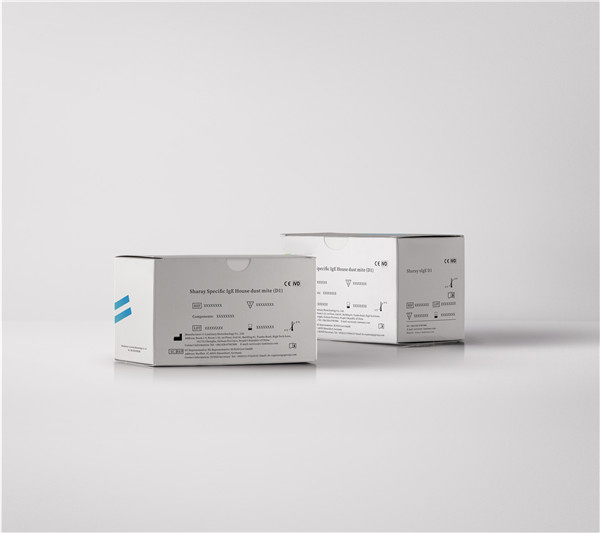Allergen-specific IgE Test Kit
| Chemiluminescent Solution(Allergy) | ||
| Series | Product Name | Product Name |
| Allergen-specific IgE | House dust mite D1 | Ribwort W9 |
| Dust mite D2 | Kentucky blue grass G8 | |
| Cat dander E1 | Cultivated rye G12 | |
| Dog dander E5 | Pistachio F203 | |
| Sesame seed F10 | Maple leaf sycamore, London plane, Plane tree T11 | |
| Peanut F13 | Latex K82 | |
| Soybean F14 | Olive T9 | |
| Milk F2 | Strawberry F44 | |
| Crab F23 | Cypress T23 | |
| Shrimp F24 | Almond F20 | |
| Egg F245 | cross-reactive carbohydrate determinants CCD | |
| Beef F27 | White Ash T15 | |
| Codfish F3 | Apple F49 | |
| Wheat F4 | Cladosporium herbarum M2 | |
| Mutton F88 | Penicilloyl G C1 | |
| House dust H1 | Penicilloyl V C2 | |
| Cockroach, German I6 | Amoxicilloyl C6 | |
| Aspergillus fumigatus M3 | Guinea pig epithelium E6 | |
| Alternaria M6 | Rye F5 | |
| Willow T12 | Rice F9 | |
| Common ragweed W1 | Tomato F25 | |
| Mugwort W6 | Pork F26 | |
| Cocksfoot G3 | Carrot F31 | |
| Common silver birch T3 | Potato F35 | |
| Hazel T4 | Yeast F45 | |
| Egg white F1 | Egg yolk F75 | |
| Timothy grass G6 | Gluten F79 | |
| Garlic F47 | Peach F95 | |
| Kiwi F84 | Apricot F237 | |
| Celery F85 | Walnut F256 | |
| Mustard F89 | Bermuda grass G2 | |
| Banana F92 | Johnson grass G10 | |
| Oak T7 | Velvet grass G13 | |
| Goosefoot W10 | Bahia grass G17 | |
| Hazel nut F17 | Honey bee venom I1 | |
| Horse dander E3 | Yellow jacket venom I3 | |
| Rabbit epithelium E82 | Paper wasp venom I4 | |
| Hamster epithelium E84 | Penicillium chrysogenum M1 | |
| Meadow fescue G4 | Grey alder T2 | |
| Rye-grass G5 | Mountain juniper T6 | |
| Cultivated wheat G15 | Eastern Wall pellitory W19 | |
| Beech T5 | Spreading pellitory W21 | |
| European ash T25 | Japanese Hop W22 | |
| Dandelion W8 | / | |
Allergic diseases are conditions in which a patient inhales or ingests substances containing allergenic components (called allergens or allergens, allergen) that trigger the body’s B cells to produce excessive immunoglobulin E (IgE). When IgE antibodies are re-exposed to allergens in vivo, they cross-link with allergens and bind to the higher affinity receptor FcεRI on the surface of mast cells and basophils, resulting in FcεRI accumulation and mast cell and basophil activation. During activation, mast cells degranulate and release histamine, an inflammatory mediator stored in cytoplasmic granules, and leukotrienes, immunoreactive prostaglandins, cytokines and chemokines such as IL-4 and IL-5 synthesized through arachidonic acid pathway, triggering disease symptoms of allergic reactions (or allergic reactions), such as allergic asthma, hay fever, urticaria, allergic rhinitis, eczema, allergic dermatitis, conjunctivitis and gastrointestinal dysfunction. The detection of different kinds of allergen-specific IgE antibodies in serum can be used for auxiliary diagnosis of whether some symptoms are caused by allergy in clinical practice.
Immunoglobulin IgE is an antibody that mediates type I allergic reactions, and allergen-specific IgE is present in the serum of allergic patients, which is called specific IgE. Those allergic to milk have IgE against milk allergens; those allergic to artemisinin pollen have IgE against the pollen. Allergens enter the body to induce the production of specific IgE, which binds to mast cells and basophils, allowing the body to enter a state of specific sensitization to this allergen. When the allergen comes into contact again, it binds to the IgE receptor on the cell membrane and causes a series of biochemical reactions, which subsequently release various bioactive mediators related to allergic reactions and inflammation, such as histamine. Since this antibody can only specifically bind to this allergen, it is necessary to use purified allergen instead of anti-IgE for detection. There are many specific IgE assay methods, such as ELISA, FEIA, and immunoblotting are commonly used in clinical practice.
Professional technical engineer dedicated to guide you
According to your actual needs, choose the most reasonable overall design and planning procedures
